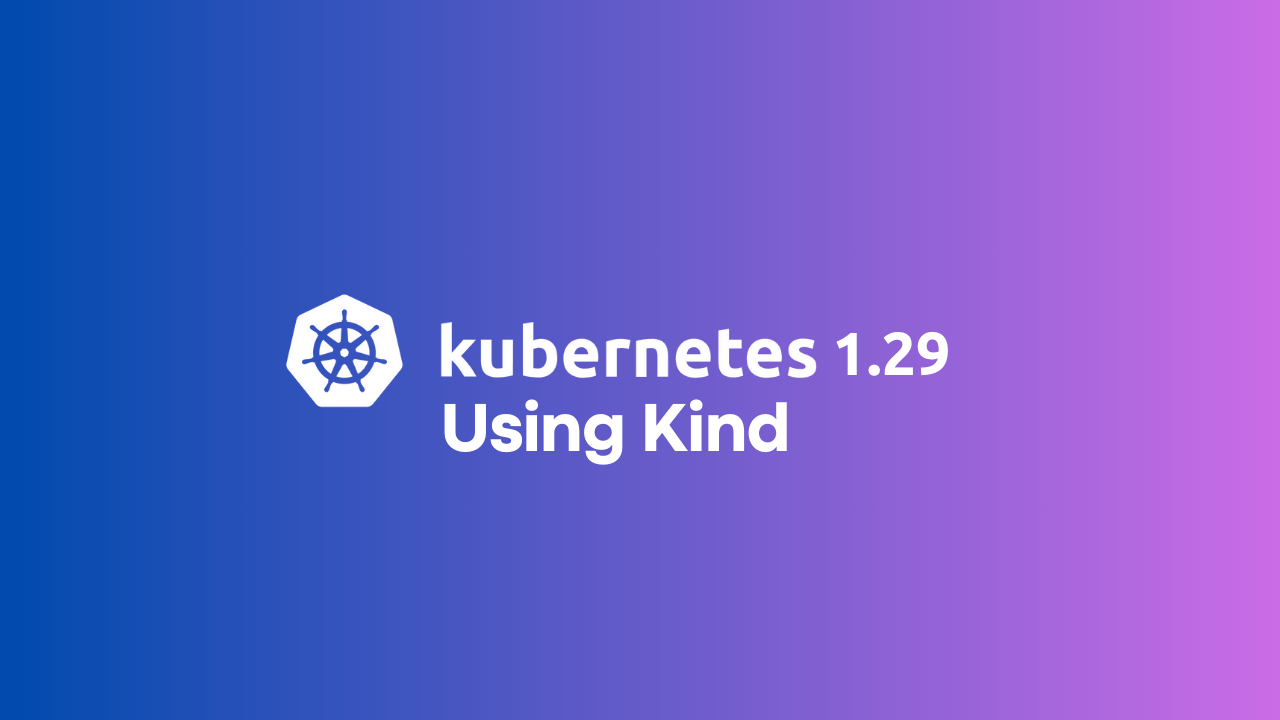Exploring Kubernetes 1.29 with Kind
-
 Gineesh Madapparambath
Gineesh Madapparambath
- Kubernetes, Kind cluster kubernetes 1.29, Kind kubernetes
- December 26, 2023

What is Kind (Kubernetes IN Docker)?
Kind, short for Kubernetes IN Docker, is a tool designed to simplify the process of creating Kubernetes clusters for local development and testing. Leveraging Docker containers, Kind enables users to spin up Kubernetes clusters quickly and efficiently on their local machines. It provides an easy way to experiment with different Kubernetes versions, configurations, and scenarios without the need for external infrastructure. Kind’s flexibility and speed make it an ideal choice for developers and testers looking to replicate Kubernetes environments in a lightweight and portable manner.
Exploring Kubernetes with Kind
Kind (Kubernetes IN Docker) makes it easy to create Kubernetes clusters for testing and development. Let’s dive into setting up Kind and experimenting with different configurations.
Install Kind
Get started by installing Kind. Visit the Kind Quick Start page for installation instructions.
Create a Kind Cluster
Use the following commands to create a basic Kind cluster:
$ kind create cluster --name test-kind
This command sets up a default cluster with one control plane node. This is the easiest way to spin up a Kubernetes cluster.
Kind will use Docker as the default provider. Now, if you want to use Podman as the provider, you can use the following method
$ KIND_EXPERIMENTAL_PROVIDER=podman kind create cluster --name test-kind
But we want to create a multi-node Kubernetes cluster and not just a single node here. For that, we need to use the cluster configuration file. Before that, let’s delete the cluster as follows.
$ kind delete cluster
Customize Your Cluster with a Config File
Create a config file, for example, ~/.kube/kind_cluster , with the following content:
kind: Cluster
apiVersion: kind.x-k8s.io/v1alpha4
nodes:
- role: control-plane
image: kindest/node:v1.29.14@sha256:8703bd94ee24e51b778d5556ae310c6c0fa67d761fae6379c8e0bb480e6fea29
- role: worker
image: kindest/node:v1.29.14@sha256:8703bd94ee24e51b778d5556ae310c6c0fa67d761fae6379c8e0bb480e6fea29
- role: worker
image: kindest/node:v1.29.14@sha256:8703bd94ee24e51b778d5556ae310c6c0fa67d761fae6379c8e0bb480e6fea29
- role: worker
image: kindest/node:v1.29.14@sha256:8703bd94ee24e51b778d5556ae310c6c0fa67d761fae6379c8e0bb480e6fea29
Then, create a cluster using this config:
$ kind create cluster --config ~/.kube/kind_cluster
using podman due to KIND_EXPERIMENTAL_PROVIDER
enabling experimental podman provider
Creating cluster "kind" ...
✓ Ensuring node image (kindest/node:v1.32.2) 🖼
✓ Preparing nodes 📦 📦 📦 📦
✓ Writing configuration 📜
✓ Starting control-plane 🕹️
✓ Installing CNI 🔌
✓ Installing StorageClass 💾
✓ Joining worker nodes 🚜
Set kubectl context to "kind-kind"
You can now use your cluster with:
kubectl cluster-info --context kind-kind
Have a question, bug, or feature request? Let us know! https://kind.sigs.k8s.io/#community 🙂
Specify Kubernetes Version
To use a specific Kubernetes version, provide the --image flag. For example, the following command will create the cluster with Kubernetes 1.29 version.
$ kind create cluster \
--name my-kind-cluster \
--config ~/.kube/kind_cluster \
--image kindest/node:v1.29.0@sha256:eaa1450915475849a73a9227b8f201df25e55e268e5d619312131292e324d570
You can replace v1.29.0 and the SHA256 with your desired version. Refer to the kindest/node image tags to find the available versions.
Cluster Access
After the cluster is created, Kind provides instructions for accessing it. Set the kubectl context and explore your cluster:
$ kubectl cluster-info --context kind-my-kind-cluster
Kubernetes control plane is running at https://127.0.0.1:33805
CoreDNS is running at https://127.0.0.1:33805/api/v1/namespaces/kube-system/services/kube-dns:dns/proxy
To further debug and diagnose cluster problems, use 'kubectl cluster-info dump'.
$ kubectl get nodes
NAME STATUS ROLES AGE VERSION
my-kind-cluster-control-plane Ready control-plane 64s v1.29.0
my-kind-cluster-worker Ready <none> 40s v1.29.0
my-kind-cluster-worker2 Ready <none> 41s v1.29.0
Now you’re ready to harness the power of Kubernetes 1.29 with Kind! Happy exploring.

Gineesh Madapparambath
Gineesh Madapparambath is the founder of techbeatly. He is the co-author of The Kubernetes Bible, Second Edition and the author of Ansible for Real Life Automation. He has worked as a Systems Engineer, Automation Specialist, and content author. His primary focus is on Ansible Automation, Containerisation (OpenShift & Kubernetes), and Infrastructure as Code (Terraform). (Read more: iamgini.com)
Note
Disclaimer: The views expressed and the content shared in all published articles on this website are solely those of the respective authors, and they do not necessarily reflect the views of the author’s employer or the techbeatly platform. We strive to ensure the accuracy and validity of the content published on our website. However, we cannot guarantee the absolute correctness or completeness of the information provided. It is the responsibility of the readers and users of this website to verify the accuracy and appropriateness of any information or opinions expressed within the articles. If you come across any content that you believe to be incorrect or invalid, please contact us immediately so that we can address the issue promptly.


